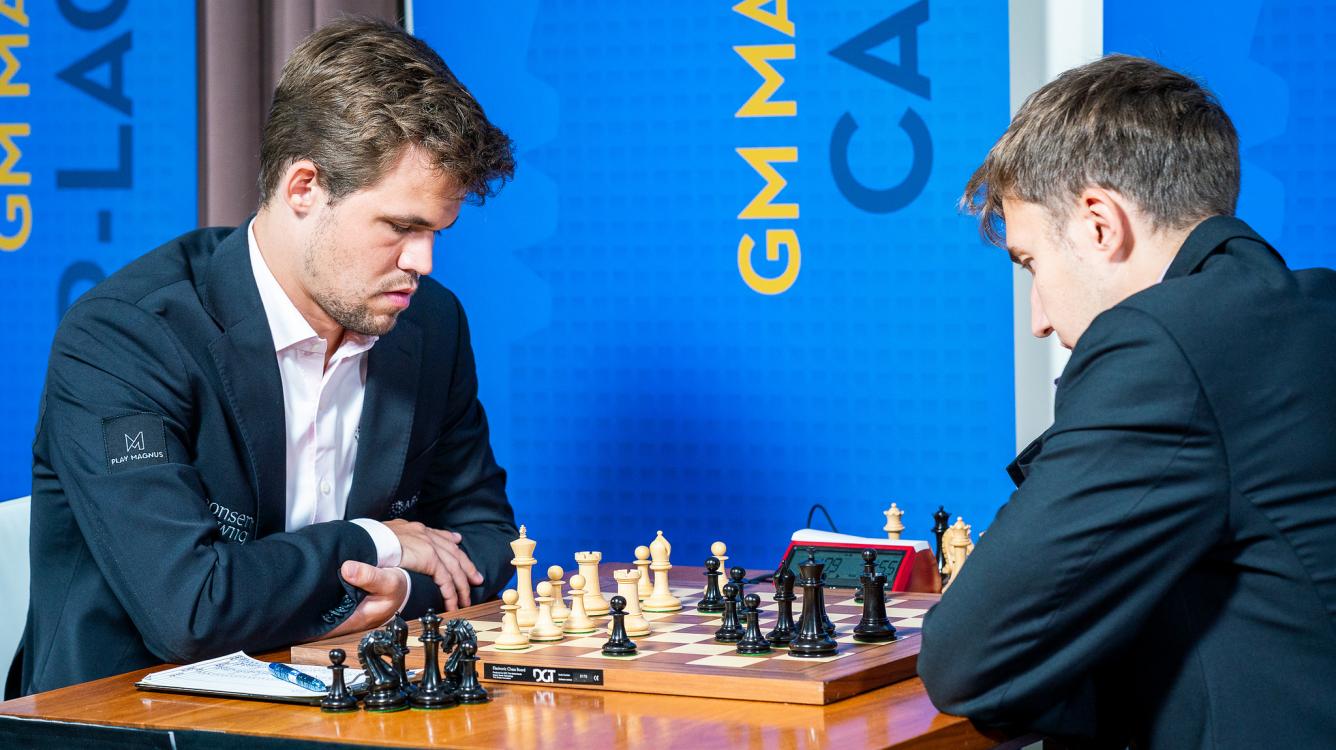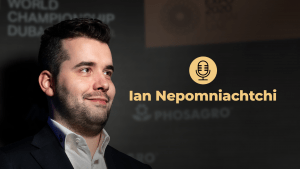
Carlsen Wins 'Throwback' Game To Join Sinquefield Leaders
Magnus Carlsen wanted to know what constituted a draw; he just didn't want one himself. After more than 6.5 hours of pressing, he finally edged Sergey Karjakin in the dwindling seconds of the game.
Long before that, prior to the start of the second round of the 2018 Sinquefield Cup, a closed-door players meeting took place to discuss the tournament's procedures on draws.
Maybe some of the players took it too literally. The first four games ended without a winner, with two lasting less then two hours. Shakhriyar Mamedyarov and Levon Aronian seemed like they'd be the only leaders again, until the world champion's tenacity finally broke down his 2016 world championship opponent.

The 6.5-hour stare-down worked today for Magnus Carlsen. | Photo: Lennart Ootes/Grand Chess Tour.
Let's start with the game of the round, and then move on to the finer points of chess rules after that.
Carlsen was in great spirits after his win, no matter how long it took. He ground it out, knowing that the waning moments of the game would make it very hard for his opponent to hold. Despite the 88-mover, he was not in any particular hurry to leave the Saint Louis Chess Club.
"It was a throwback game," Carlsen told Chess.com. "I haven't been winning many of these types of games lately. I didn't really have the opportunity at the world championship. It's massive for me."

Carlsen's shoes -- if they weren't broken in before this round, they certainly were afterward. | Photo: Lennart Ootes/Grand Chess Tour.
He said he didn't have "major hopes" after trading queens, but he always had this lingering idea of offering the exchange. He found the right moment, and that allowed Magnus to be Magnus. To him, that felt great again.
That feeling almost didn't come. Karjakin nearly held by oscillating his pieces for many moves, then finding the active defense 67...g5+!
"That move took some nerve to play because he's been holding the bunker," GM Yasser Seirawan said. Alas, in Karjakin's final seconds it also ended up leaving him with more decisions once play opened up. Ten moves later he made his one big error of the game.

"As soon as he got down to the delay, I felt it would be very, very hard not to blunder," Carlsen predicted. And he was right.
"I feel like I did everything I could. Sometimes it's enough, sometimes it's not."
Now on to the rules. The gathering before round two was precipitated by the Hikaru Nakamura vs. Viswanathan Anand game yesterday, and the interpretation of a variation of the "Sofia Rules" in place. Section 8 of the Grand Chess Tour Regulations states that in any classical time-control games, a draw may only be reached in case of a repetition, 50-move rule, or a "completely drawn position in the endgame." It's that last ambiguity that was challenged.
When Anand and Nakamura called it a day yesterday, they correctly asked Chief Arbiter Chris Bird if their queen-and-five against queen-and-five ending was sufficient for the last clause. Bird, who has a FIDE rating of 2088, agreed. That was seemingly that.

Chief Arbiter Chris Bird checks to see how much time the meeting took, and it was time to play some chess. | Photo: Mike Klein/Chess.com.
However, Nakamura told Chess.com that as it was happening, both Levon Aronian and Magnus Carlsen were chirping about the position perhaps not being simplistic enough for the draw to be awarded.
At today's meeting, which press was not allowed to attend, Bird gathered the players and their seconds to clarify what had happened, and what he hoped to see going forward. Both Nakamura and Fabiano Caruana told Chess.com that the meeting was mostly to clear the air with Carlsen's objections, although Bird said that he called the meeting himself, without prompting from anyone.

Nakamura-Anand, round one, final position. Chief Arbiter Chris Bird upheld the draw claim here.
"It's Magnus making much ado about nothing," Nakamura told Chess.com after his game ended today. "It was more about placating Magnus than anything.
"Ultimately it is on the arbiter to make the decision...That's the problem with the rules. If you have any sort of arbiter involvement, and the arbiter decides."

Hikaru Nakamura told Chess.com he can think of more unclear positions that were awarded draws under the same rules. | Photo: Mike Klein/Chess.com.
Nakamura said that Bird advised players to go for a repetition when possible. None of the draws in round two required Bird's intervention -- they were all by way of repetition.
"I didn't see the point in the meeting at all," Caruana told Chess.com. "I don't know why Magnus complained about the position yesterday."

Bird has some fun before the private meeting, or was he taunting those denied entry?! | Photo: Mike Klein/Chess.com.
Bird told Chess.com that he admits yesterday's ruling was a "mistake" (but which almost certainly didn't affect the outcome). He seems to be calling a foul on himself since Bird said the GCT did not have any issues with the ruling.
Still, Bird wanted to let the players know that sort of position would not be awarded a draw going forward.
Watch IA Chris Bird On Sofia Draw Rules from Chess on www.twitch.tv
Finally, a second clarification came about at the meeting (which was not part of any controversy yesterday). After exhaustive research last night by Bird with the Grand Chess Tour and FIDE, it was determined that players do have to keep notation the entire game, even when below five minutes. According to Bird, the 30-second delay is indeed tantamount to a 30-second increment for purposes of the rules.

Alexander Grischuk usually tells jokes, but today he played against one. | Photo: Lennart Ootes/Grand Chess Tour.
Alexander Grischuk vs. Shakhriyar Mamedyarov was an offbeat French with tons of asymmetry. It was also a carbon copy of Shankland-Ashwin, Millionaire Open 2016. But that's not the way the Russian remembers it.
"In my home I have this in my notes as a joke line!" Grischuk said. "French Defense -- joke line. You are not supposed to face joke lines."
Grischuk's draw yesterday against Caruana and his subsequent game against Mamedyarov today produced a funny quirk in the live ratings.
"What's funny is that yesterday I played the number two player in the world and today I played the number two player in the world!" he said.
Viswanathan Anand faced Vachier-Lagrave in a reprisal of a game played last week in the rapid.
"I liked my position before the game," Anand said about his preparation. He was not surprised by Vachier-Lagrave's differentiation from the Caruana game (Anand played the next several moves without much time used).
"Maxime felt he had just enough counterplay," Anand said.

Still too much spring in Maxime Vachier-Lagrave's step for the doctor to limit his Najdorfs. | Photo: Spectrum Studios.
Vachier-Lagrave admitted that this white setup has given him some fits.
"So far I haven't been able to get a safe position out of this line," he said. "I understand why they pick a fight with it...I was not really getting positions that were pleasing to the eye."
To Chess.com, the Frenchman said he wouldn't reveal everything he learned from the rapid game with Caruana. "Of course I wasn't going to repeat blindly what I played against Fabi," he said.
For those worried that Vachier-Lagrave might one day quit his most treasured opening, don't be.
"As long as the doctor doesn't tell me to stop playing the Najdorf!" he said.
In the final two games, Caruana drew Aronian and Wesley So drew Nakamura.
Caruana tried to do a double surprise by playing 1. d4 against his opponent, and then follow it up with an early Qb3. He said he's not completely foreign to opening with the queen's pawn, but rather he just hasn't opted for it much against Aronian.
"It's not the best use of my whites," Caruana said about his two opening draws, both with the first move.

Fabiano Caruana, hoping for a bughouse tiebreak at the world championship? | Photo: Mike Klein/Chess.com.
Aronian heaped praise on Caruana afterward, and not just about the 64 squares. He said his opponent has improved a lot on the 128 squares. Aronian would pick Caruana first amongst all other Sinquefield players as a bughouse partner.
At the opening ceremony, Aronian told Chess.com that Caruana is about a 2100 in bughouse and he fashions himself around 2400. Chess.com then asked Caruana if he agrees with those estimates.
"There's no objective way to measure," Caruana said, since the partner is so vital to the equation. He said he agreed that Aronian is superior, but "I would put our strengths a little closer together."


Graphics courtesy Spectrum Studios.
The Sinquefield Cup, the final qualification leg of the Grand Chess Tour, is a nine-round tournament from August 17-28. At the end of the tournament, four players will qualify for the London finals. The games in St. Louis begin at 1 p.m. Central U.S. time daily (8 p.m. Central Europe).
Earlier reports:


